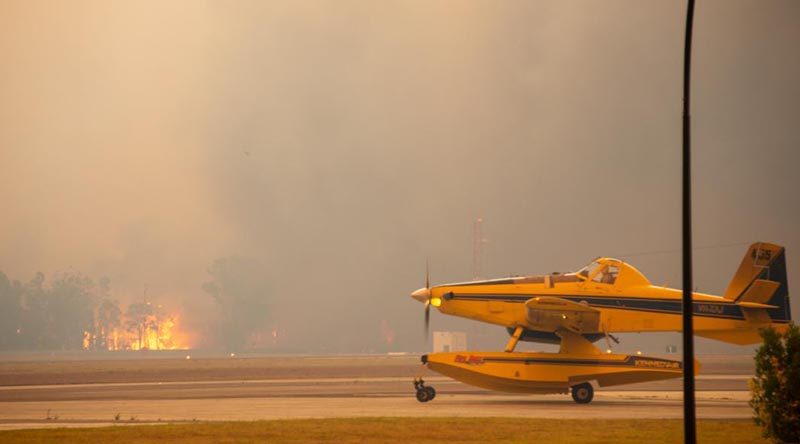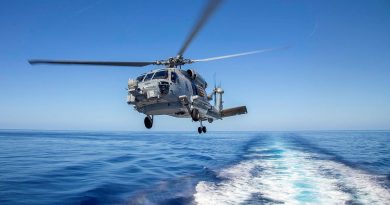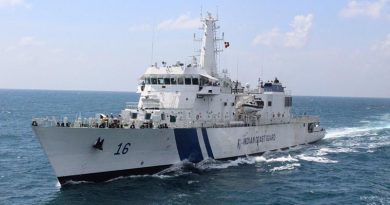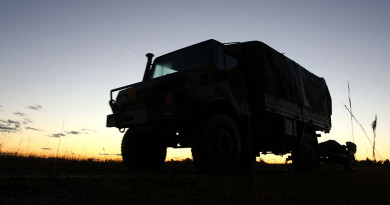Bushfire threat to Albatross much worse than earlier report
Share the post "Bushfire threat to Albatross much worse than earlier report"

For those on duty at HMAS Albatross on NYE, the irony of launching helicopters to assist the bushfire fight elsewhere while the base came under serious fire threat wasn’t lost.
CAPTION: Graphic evidence of how close the bushfires came to HMAS Albatross on New Year’s Eve, even as military and civilian aircraft continued bushfire-support operations from the base.
RELATED STORIES: Albatross praised for bushfire support while base smouldered –– Operation Bushfire Assist 19-20
At about 10.30am, half an hour after north-westerly winds began buffeting the base near Nowra on the NSW south coast, Albatross Commanding Officer Captain Robyn Phillips saw flames at the western edge of the airfield.
“I didn’t know what would be left of Albatross. We had fire licking at the doorstep and we knew it was going to be a bad day,” she said.
As the base’s senior ADF officer, Captain Phillips enacted emergency powers, taking command of all military and civilians, short-circuiting regular command chains.
Fire travelled around Albatross’ western perimeter fence, then spotted across the grass around the runway’s north side and continued near the Fleet Air Arm Museum and the Parachute Training School.
“We’d see black plumes of smoke on the horizon and wonder if that was someone’s house that had gone up,” Captain Phillips said.
By 3pm, sunlight couldn’t penetrate the black smoke surrounding Albatross.
Contractors and firefighters drove around the airfield extinguishing small blazes ignited by embers ahead of something much bigger.
“We were just waiting for that fire front to come up Nowra Hill and get us,” Captain Phillips said.
Everyone who wasn’t supporting aircraft operations moved into one building, where about 40 people sheltered, including two civilians who had lost their home at nearby Nerriga.
“This was before we officially opened up as a civilian place of refuge, but I wasn’t going to turn them away,” Captain Phillips said.
Volunteer firefighters protected the building with hoses and a fire truck at each end.
“I’d seen images on TV and wondered if those firies outside were going to be able to make a difference,” Captain Phillips said.
At the last minute, the wind changed and pushed the fire back on itself.
It was a harrowing start for Captain Phillips, who had only taken command of the base on December 12, and within a week had given her first orders to remove non-essential personnel in the face of their first fire threat.
Albatross has been supporting this season’s firefighting efforts since late November when the RFS aviation element first arrived.
In mid-December, civilian firefighters and trucks began staging from the base.
Many rooms were reserved for firefighters transiting or staying on board and the Junior Sailors’ mess worked through the holidays to keep everyone fed.
Army engineers and plant equipment are still staging from Albatross, while about 80 infantrymen on board are travelling to assist fire-affected communities.
MRH-90s operated from HMAS Albatross – even while the base was under serious threat
The recent arrival of three New Zealand Defence Force NH90 helicopters means remaining base accommodation might only appeal to those who love the outdoors.
“It depends how much you like staying in tents,” Captain Phillips said.
“We don’t have a lot of rooms left but we’ve identified areas where we can set up tents once we’re no longer going to come under ember attack.”
Albatross experienced two such attacks so far this fire season.
The base is in the midst of a fire zone and provides firefighters a staging point to respond.
“We have the infrastructure, we have people to give them a hand helping their aircraft refuel and re-water – on some days it gets very busy,” Captain Phillips said.
During the worst ember attack, small blazes ignited deeper inside the base, including one between accommodation blocks.
“My staff were discovering spot fires and pulling out hoses to put them out,” Captain Phillips said.
Charred gum trees and burnt grass surrounding the flightline serve as a stark reminder of how close things came at Albatross.
Despite this, firefighting and military aircraft stand against the blackened landscape, ready for more missions.
.
.
.
.
.
.

.
.
Share the post "Bushfire threat to Albatross much worse than earlier report"






As an old EX-RAAF Firie, I felt a strong tug of PRIDE OF SERVICE for the younger guys facing the WORST FIRES in Australia’s History. The navy did an excellent Job in Evacuation of Civilians, and it was tears of pride to see Navy being respected and honoured by the Evacuees. A little later, RAAF also helped with support against the fires, as did Our Army… I dont remember feeling so PROUD of all our Armed Forces Personnel doing such a great job, and seeing the Civilian response and joy at the help given was very memorable. Only, NOT SEEN IN THE Photos I saw of HMAS Albatross, absent were some of the BEST Fire-Fighting vehicles the Armed Forces ever had… Was Albatross provided with TFA’s like P4’s or later Fire vehicles? I loved my P4… It could handle 2 fire simultaneously, and using FOAM so as to drench fire-ground better, and drop flames like they were never there!